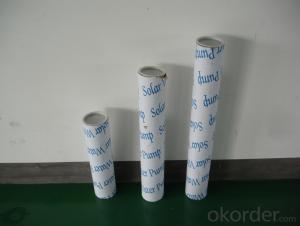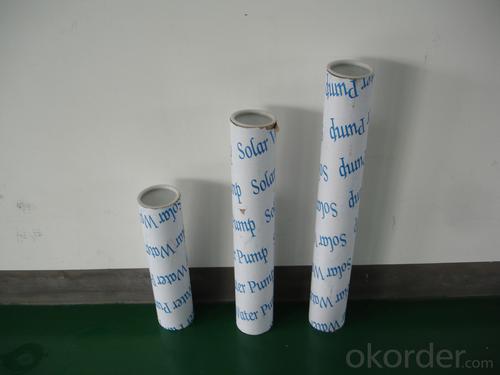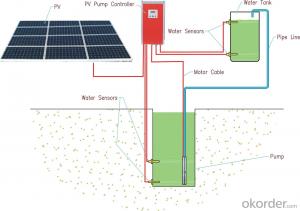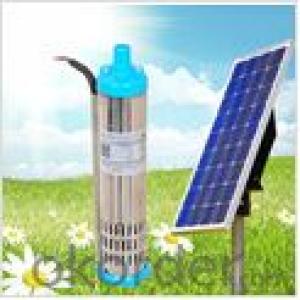Large Solar DC Submersible Pumps
- Loading Port:
- China Main Port
- Payment Terms:
- TT OR LC
- Min Order Qty:
- -
- Supply Capability:
- -
OKorder Service Pledge
OKorder Financial Service
You Might Also Like
Item Description :
This superb new addition to our solar fountain range comes with a 10w solar panel,and a powerful fountain pump that is capable of producing fountains of up to 2m in height. As well as being easy to set up and use.Instruction manual is supplied for assembly and maintenance.
Solar Fountain Key Features :
Powered by direct sunlight
No high voltage electric mains required
Safe for children
Max. height of fountain: 2M
Max. flow capacity: 800 L/H(176 GAL)
10W Polycrystalline solar panel included
18V DC brushless pump
Solar Pump Features :
Can produce fountains up to : 2M (tube height) 1.4M (fountain height)
Comes with multiple nozzle accessories
Cable Length : 5M
Solar Panel Features :
10W peak power.
Polycrystalline highly efficient solar panel
Comes mounted in aluminium frame
Comes with ground stake and rotating knob so you can angle your panel toward the sun
What You Will Get :
10W solar panel
Solar pump
Ground Sake
Nozzle accessories
Precautions :
DO NOT alter or change the product itself or its components
Operate pump in freshwater only, never above 50 degrees celsius
Keep away from flammable liquids
Do not connect to any other power supply other than the included
- Q: Can a solar pump be used for water supply in off-grid farms?
- Yes, a solar pump can be used for water supply in off-grid farms. Solar pumps are a sustainable and cost-effective solution for farms located in remote areas without access to traditional power sources. They harness energy from the sun to power the pump, allowing for reliable water supply for irrigation, livestock, and other agricultural needs. This eliminates the dependence on grid electricity and reduces operational costs while promoting environmental sustainability.
- Q: Are there any limitations on the water pressure or flow rate for a solar pump?
- Yes, there are limitations on the water pressure and flow rate for a solar pump. The specific limitations depend on the capacity and design of the solar pump, as well as the available solar energy. Generally, solar pumps have a maximum pressure and flow rate specified by the manufacturer. These limitations ensure the efficiency and longevity of the pump system and prevent any potential damages.
- Q: Can a solar pump be used for water treatment or purification?
- Water treatment or purification can indeed utilize a solar pump. These pumps harness the power of the sun to operate, enabling the transfer of water from one place to another. This proves particularly advantageous for water treatment or purification, as it eliminates the need for external power sources and reduces expenses. Various water treatment or purification tasks can benefit from the use of solar pumps. For instance, they can transport water from wells or boreholes to treatment facilities. They can also facilitate the movement of water through different treatment stages, including filtration, disinfection, or desalination. Moreover, solar pumps can circulate water within a treatment system to ensure proper mixing and sufficient contact time with treatment chemicals or processes. Employing a solar pump for water treatment or purification offers numerous advantages. Firstly, it presents a sustainable and eco-friendly solution due to its reliance on renewable energy. Additionally, solar pumps can be installed in remote or off-grid areas where access to electricity is limited or nonexistent. Consequently, they prove suitable for rural communities or underdeveloped regions lacking infrastructure. Moreover, solar pumps often prove more cost-effective in the long run compared to traditional pumps, as they incur lower operational and maintenance costs. Furthermore, they guarantee a dependable and continuous water supply, even during power outages or fluctuations. However, it is crucial to acknowledge that relying solely on a solar pump may not suffice for comprehensive water treatment or purification. Depending on specific requirements and the quality of the water source, additional treatment processes or technologies may be necessary to ensure the safety and potability of the water. In conclusion, a solar pump unquestionably serves as a viable option for water treatment or purification, offering a sustainable, cost-effective, and dependable solution for diverse applications.
- Q: Can a solar pump be used for hydroponic farming systems?
- Yes, a solar pump can be used for hydroponic farming systems. Solar pumps are an environmentally friendly and cost-effective solution for providing water circulation and nutrient delivery in hydroponic systems. They can effectively power the necessary water flow and can be easily integrated into the overall setup.
- Q: Do solar pumps require maintenance?
- Yes, solar pumps require regular maintenance to ensure optimal performance and longevity. This includes cleaning the solar panels to remove dust and debris, inspecting the pump system for any leaks or damage, and checking the battery and electrical connections. Additionally, routine maintenance may also involve lubricating moving parts and replacing worn-out components. Proper and timely maintenance is essential for the efficient operation of solar pumps.
- Q: Can a solar pump be used in remote locations?
- Yes, a solar pump can be used in remote locations. Solar pumps are ideal for remote areas where there is no access to grid electricity. They can operate using solar energy, which is abundant in most remote locations, making them a reliable and sustainable solution for water pumping needs.
- Q: How long does a solar pump last?
- The lifespan of a solar pump typically depends on various factors such as the quality of the pump, regular maintenance, and usage conditions. On average, a well-maintained solar pump can last anywhere between 15 to 25 years.
- Q: Can a solar pump be used in areas with limited access to water conservation?
- Yes, a solar pump can be used in areas with limited access to water conservation. Solar pumps are designed to harness energy from the sun and convert it into mechanical energy to pump water. They do not rely on grid electricity or fuel, making them suitable for remote locations with limited access to water conservation. The use of solar pumps can help improve access to water for agriculture, livestock, and domestic purposes in areas where water conservation is crucial.
- Q: Can solar pumps be used for water supply in recreational facilities or parks?
- Yes, solar pumps can be effectively used for water supply in recreational facilities or parks. Solar pumps are a sustainable and environmentally friendly solution that utilize energy from the sun to power water pumping systems. They can efficiently provide water for various purposes such as irrigation, fountains, or even drinking water supply in these recreational areas. Solar pumps offer a cost-effective and reliable alternative to traditional electricity-dependent pumps, making them an ideal choice for water supply in parks and recreational facilities.
- Q: Can solar pumps work at night or on cloudy days?
- No, solar pumps are dependent on sunlight to generate electricity, so they are not operational during the night or on cloudy days when sunlight is limited.
Send your message to us
Large Solar DC Submersible Pumps
- Loading Port:
- China Main Port
- Payment Terms:
- TT OR LC
- Min Order Qty:
- -
- Supply Capability:
- -
OKorder Service Pledge
OKorder Financial Service
Similar products
Hot products
Hot Searches
Related keywords





















